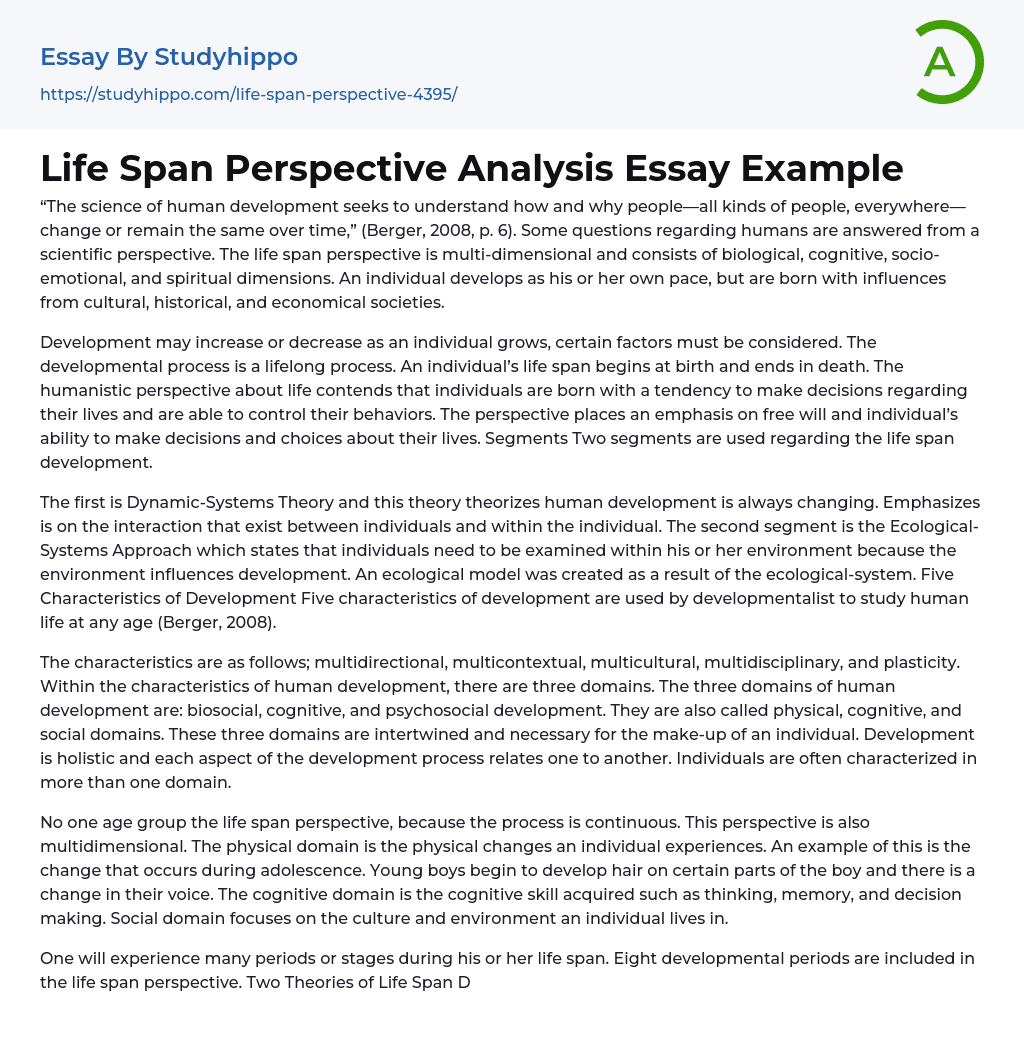"The science of human development seeks to understand the causes and mechanisms behind the changes or consistencies observed in people's lives, regardless of their diverse characteristics or geographical location," (Berger, 2008, p. 6). Scientific investigation offers explanations for different aspects of human existence. The life span perspective includes various dimensions like biological, cognitive, socio-emotional, and spiritual aspects. Each individual develops at their own pace while societal influences such as culture, history, and economy also have a significant impact from birth onwards.
Development is a lifelong process that can differ in an individual's growth. It is crucial to take into account the factors that influence development throughout one's entire life, from birth until death. As per the humanistic perspective, individuals possess an inherent capacity to make choices and govern their own actions.
This text highlights the importance of free will and the ability for individuals to make
...choices about their own lives. It discusses two aspects of life span development: the Dynamic-Systems Theory, which suggests that human development is always changing, and emphasizes the interactions between individuals and within each individual.
The significance of considering individuals in relation to their environment, as it influences their development, is highlighted by the Ecological-Systems Approach. This approach led to the creation of an ecological model. Researchers studying human life at any stage utilize five characteristics: multidirectional, multicontextual, multicultural, multidisciplinary, and plasticity (Berger, 2008).
Human development comprises three domains: biosocial, cognitive, and psychosocial (also known as physical, cognitive, and social) development. These domains are interconnected and crucial for an individual's overall makeup. The holistic nature of development means that each aspect is related to one another.
Individuals can be characterized in multiple domains, as the
life span perspective recognizes that the process is ongoing and encompasses various dimensions. One such dimension is the physical domain, which involves the physical changes that individuals go through. For instance, adolescence brings about changes like the growth of hair in specific areas and a transformation in voice.
The cognitive domain involves the development of cognitive skills like thinking, memory, and decision making. In contrast, the social domain encompasses an individual's culture and environment. Over a lifespan, individuals experience different periods or stages. The life span perspective includes eight developmental periods.
Two main theories, psychoanalytic theory and behaviorism (also called learning theory), are central to understanding human development (Berger 2008). Psychoanalytic theory suggests that unconscious drives and motives, often rooted in childhood experiences, account for human behavior. Sigmund Freud is recognized as the founder of psychoanalytic theory (Berger, 2008, p. 35).
Freud's theory originated from his work with individuals who had mental illness. He proposed that there are three stages of development where sexual pleasure is the main factor. According to Freud, if sensual satisfaction is not achieved during these stages, it will have repercussions in adulthood (Berger, 2008). Behaviorism, also known as learning theory, is a comprehensive study of human development that explores observable behavior (Berger, 2008, p. 8). Psychologist John Watson emphasized the importance of observing and documenting individuals' behaviors (Berger, 2008).
Watson had the belief that knowledge can be acquired and people can be educated on how to act. Social learning theory and cognitive learning theory are two other important theories in the field of life span development. The Sociocultural theory highlights the impact of external factors on an individual, while the epigenetic theory emphasizes the
role of internal influences. The debate between nature and nurture, referring to the effects of heredity and environment, is also significant.
Although there may be a discussion about genetics versus learning, they ultimately relate to the same concept. People are born with distinctive genetic characteristics, but their growth is affected by their surroundings. As stated by Berger (2008), culture greatly influences every aspect of human existence.
While some individuals resist traditional cultures, these behaviors persist and evolve over time as they are transmitted from one generation to the next. People can be simultaneously influenced by multiple cultures, as various cultural influences coexist. The term "nurture" pertains to the environmental factors that shape an individual's development from birth, while "nature" refers to inherited characteristics from parents.
Both nature and nurture are interconnected and play a role in an individual's overall growth. They influence all aspects of life, including inherent genetic tendencies and preferences shaped by surroundings.
Conclusion
People experience ongoing transformations.
They may alter their beliefs, surroundings, and even their approach to learning. However, the constant need for knowledge and comprehending human development from environmental and social perspectives remains unchanged. Although individuals may undergo similar circumstances, the outcomes can vary. References: Berger, K.
(2008). The developing person through the life span [University of Phoenix Custom Edition eBook]. : Worth.
- Individual essays
- Infant essays
- Childhood essays
- Adolescence essays
- Growth Mindset essays
- Is Google Making Us Stupid essays
- Childhood Memory essays
- Animals essays
- Charles Darwin essays
- Agriculture essays
- Archaeology essays
- Moon essays
- Space Exploration essays
- Sun essays
- Universe essays
- Birds essays
- Horse essays
- Bear essays
- Butterfly essays
- Cat essays
- Dolphin essays
- Monkey essays
- Tiger essays
- Whale essays
- Lion essays
- Elephant essays
- Mythology essays
- Time Travel essays
- Discovery essays
- Thomas Edison essays
- Linguistics essays
- Journal essays
- Chemistry essays
- Biology essays
- Physics essays
- Seismology essays
- Reaction Rate essays
- Roman Numerals essays
- Scientific Method essays
- Mineralogy essays
- Plate Tectonics essays
- Logic essays
- Genetics essays
- Albert einstein essays
- Stars essays
- Venus essays
- Mars essays
- Evolution essays
- Human Evolution essays
- Noam Chomsky essays




